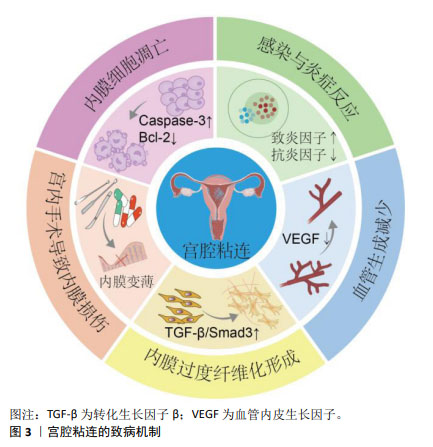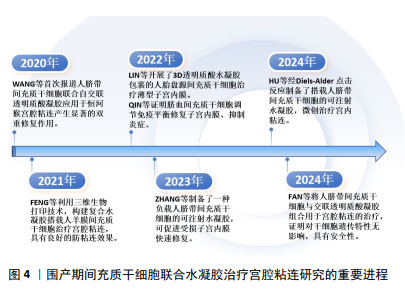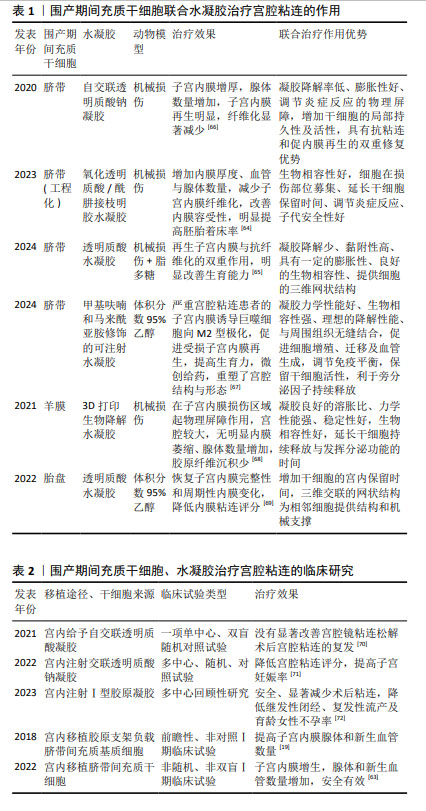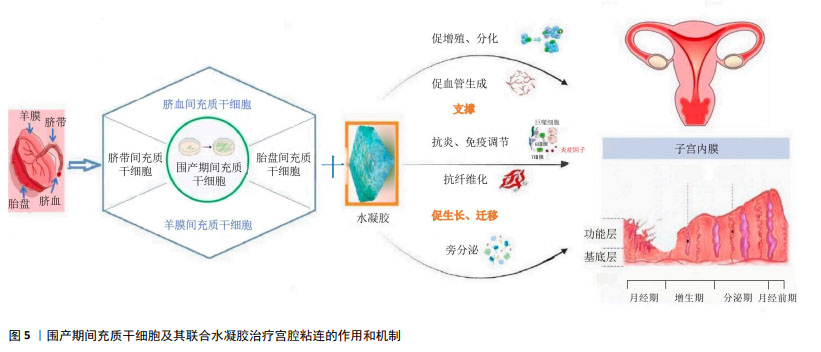[1] ZHU X, PÉAULT B, YAN G, et al. Stem Cells and Endometrial Regeneration: From Basic Research to Clinical Trial. Curr Stem Cell Res Ther. 2019;14(4): 293-304.
[2] ZHANG L, LI Y, DONG YC, et al. Transplantation of umbilical cord-derived mesenchymal stem cells promotes the recovery of thin endometrium in rats. Sci Rep. 2022;12(1):412.
[3] EMINGR M, HALAJ M, MALČÁK M, et al. Prevention of intrauterine adhesions. Ceska Gynekol. 2023;88(3):210-213.
[4] LIU T, HE B, XU X. Repairing and Regenerating Injured Endometrium Methods. Reprod Sci. 2023;30(6):1724-1736.
[5] LV Q, WANG L, LUO X, et al. Adult stem cells in endometrial regeneration: Molecular insights and clinical applications. Mol Reprod Dev. 2021;88(6): 379-394.
[6] WANG PH, YANG ST, CHANG WH, et al. Intrauterine adhesion. Taiwan J Obstet Gynecol. 2024;63(3):312-319.
[7] DREISLER E, KJER JJ. Asherman’s syndrome: current perspectives on diagnosis and management. Int J Womens Health. 2019;11:191-198.
[8] DI SPIEZIO-SARDO A, DE ANGELIS MC, DIMITRIOS K, et al. Restoring Fertility of Patients with Severe Asherman’s Syndrome in the Office Setting: A Step-by-Step Recipe for Success. J Minim Invasive Gynecol. 2023;30(5):355-356.
[9] LI X, LV H F, ZHAO R, et al. Recent developments in bio-scaffold materials as delivery strategies for therapeutics for endometrium regeneration. Mater Today Bio. 2021;11:100101.
[10] NIE N, GONG L, JIANG D, et al. 3D bio-printed endometrial construct restores the full-thickness morphology and fertility of injured uterine endometrium. Acta Biomater. 2023;157:187-199.
[11] KHAN Z, GOLDBERG JM. Hysteroscopic Management of Asherman’s Syndrome. J Minim Invasive Gynecol. 2018;25(2):218-228.
[12] HOU X, LIU Y, STREULI I, et al. Endometrial Regeneration in Asherman’s Syndrome: Clinical and Translational evidence of Stem Cell Therapies. Curr Stem Cell Res Ther. 2019;14(6):454-459.
[13] PARASHAR S, PAJAI S, TARANG T. Recent Advancement in the Management of Intrauterine Adhesions Using Stem Cell Therapy: A Review Article. Cureus. 2023;15(8):e43553.
[14] LI C, HU Y. Extracellular Vesicles Derived from Mesenchymal Stem Cells as Cell-Free Therapy for Intrauterine Adhesion. Int J Stem Cells. 2023;16(3): 260-268.
[15] LIANG Y, SHUAI Q, ZHANG X, et al. Incorporation of Decidual Stromal Cells Derived Exosomes in Sodium Alginate Hydrogel as an Innovative Therapeutic Strategy for Advancing Endometrial Regeneration and Reinstating Fertility. Adv Healthc Mater. 2024;13(13):e2303674.
[16] YANG JH, CHEN CD, CHEN SU, et al. The influence of the location and extent of intrauterine adhesions on recurrence after hysteroscopic adhesiolysis. Bjog. 2016;123(4):618-623.
[17] ABUDUKEYOUMU A, LI M Q, XIE F. Transforming growth factor-β1 in intrauterine adhesion. Am J Reprod Immunol. 2020;84(2):e13262.
[18] ZHANG S, ZHANG R, YIN X, et al. MenSCs Transplantation Improve the Viability of Injured Endometrial Cells Through Activating PI3K/Akt Pathway. Reprod Sci. 2023;30(11):3325-3338.
[19] CAO Y, SUN H, ZHU H, et al. Allogeneic cell therapy using umbilical cord MSCs on collagen scaffolds for patients with recurrent uterine adhesion: a phase I clinical trial. Stem Cell Res Ther. 2018;9(1):192.
[20] LIU F, HU S, YANG H, et al. Hyaluronic Acid Hydrogel Integrated with Mesenchymal Stem Cell-Secretome to Treat Endometrial Injury in a Rat Model of Asherman’s Syndrome. Adv Healthc Mater. 2019;8(14):e1900411.
[21] KOŁODZIEJSKA M, JANKOWSKA K, KLAK M, et al. Chitosan as an Underrated Polymer in Modern Tissue Engineering. Nanomaterials (Basel). 2021;11(11):3019.
[22] KARGOZAR S, GORGANI S, NAZARNEZHAD S, et al. Biocompatible Nanocomposites for Postoperative Adhesion: A State-of-the-Art Review. Nanomaterials (Basel). 2023;14(1):4.
[23] RICHBOURG NR, WANCURA M, GILCHRIST AE, et al. Precise control of synthetic hydrogel network structure via linear, independent synthesis-swelling relationships. Sci Adv. 2021;7(7):eabe3245.
[24] WU F, LEI N, YANG S, et al. Treatment strategies for intrauterine adhesion: focus on the exosomes and hydrogels. Front Bioeng Biotechnol. 2023;11: 1264006.
[25] DE MIGUEL-GóMEZ L, LóPEZ-MARTíNEZ S, FRANCéS-HERRERO E, et al. Stem Cells and the Endometrium: From the Discovery of Adult Stem Cells to Pre-Clinical Models. Cells. 2021;10(3):595.
[26] NEYKOVA K, TOSTO V, GIARDINA I, et al. Endometrial receptivity and pregnancy outcome. J Matern Fetal Neonatal Med. 2022;35(13):2591-2605.
[27] COUSINS FL, FILBY CE, GARGETT CE. Endometrial Stem/Progenitor Cells-Their Role in Endometrial Repair and Regeneration. Front Reprod Health. 2021;3:811537.
[28] GIRI J, MODI D. Endometrial and placental stem cells in successful and pathological pregnancies. J Assist Reprod Genet. 2023;40(7):1509-1522.
[29] SALAMONSEN LA, HUTCHISON JC, GARGETT CE. Cyclical endometrial repair and regeneration. Development. 2021;148(17):dev199577.
[30] CHEN G, LIU L, SUN J, et al. Foxf2 and Smad6 co-regulation of collagen 5A2 transcription is involved in the pathogenesis of intrauterine adhesion. J Cell Mol Med. 2020;24(5):2802-2818.
[31] CHEN K, ZHENG S, FANG F. Endometrial Stem Cells and Their Applications in Intrauterine Adhesion. Cell Transplant. 2023;32:9636897231159561.
[32] HONG IS. Endometrial stem/progenitor cells: Properties, origins, and functions. Genes Dis. 2023;10(3):931-947.
[33] WEI X, LI H, CHEN T, et al. Histological study of telocytes in mice intrauterine adhesion model and their positive effect on mesenchymal stem cells in vitro. Cell Biol Int. 2024;48(5):647-664.
[34] XU C, BAO M, FAN X, et al. EndMT: New findings on the origin of myofibroblasts in endometrial fibrosis of intrauterine adhesions. Reprod Biol Endocrinol. 2022;20(1):31.
[35] LI J, DU S, SHENG X, et al. MicroRNA-29b Inhibits Endometrial Fibrosis by Regulating the Sp1-TGF-β1/Smad-CTGF Axis in a Rat Model. Reprod Sci. 2016;23(3):386-394.
[36] CHEN JM, HUANG QY, ZHAO YX, et al. The Latest Developments in Immunomodulation of Mesenchymal Stem Cells in the Treatment of Intrauterine Adhesions, Both Allogeneic and Autologous. Front Immunol. 2021;12:785717.
[37] MALDONADO VV, PATEL NH, SMITH EE, et al. Clinical utility of mesenchymal stem/stromal cells in regenerative medicine and cellular therapy. J Biol Eng. 2023;17(1):44.
[38] SAAD-NAGUIB MH, KENFACK Y, SHERMAN LS, et al. Impaired receptivity of thin endometrium: therapeutic potential of mesenchymal stem cells. Front Endocrinol (Lausanne). 2023;14:1268990.
[39] FERNáNDEZ-GARZA LE, BARRERA-BARRERA SA, BARRERA-SALDAñA HA. Mesenchymal Stem Cell Therapies Approved by Regulatory Agencies around the World. Pharmaceuticals (Basel). 2023;16(9):1334.
[40] CAI J, GUO J, WANG S. Application of Polymer Hydrogels in the Prevention of Postoperative Adhesion: A Review. Gels. 2023;9(2):98.
[41] D’AGOSTINO A, STELLAVATO A, CORSUTO L, et al. Is molecular size a discriminating factor in hyaluronan interaction with human cells? Carbohydr Polym. 2017;157:21-30.
[42] WANG B, FENG C, DANG J, et al. Preparation of Fibroblast Suppressive Poly(ethylene glycol)-b-poly(l-phenylalanine)/Poly(ethylene glycol) Hydrogel and Its Application in Intrauterine Fibrosis Prevention. ACS Biomater Sci Eng. 2021;7(1):311-321.
[43] PENNAROSSA G, ARCURI S, DE IORIO T, et al. Current Advances in 3D Tissue and Organ Reconstruction. Int J Mol Sci. 2021;22(2):830.
[44] LUO Y, SUN Y, HUANG B, et al. Effects and safety of hyaluronic acid gel on intrauterine adhesion and fertility after intrauterine surgery: a systematic review and meta-analysis with trial sequential analysis of randomized controlled trials. Am J Obstet Gynecol. 2024;231(1):36-50.35.
[45] GAO F, XU Z, LIANG Q, et al. Osteochondral Regeneration with 3D-Printed Biodegradable High-Strength Supramolecular Polymer Reinforced-Gelatin Hydrogel Scaffolds. Adv Sci (Weinh). 2019;6(15):1900867.
[46] ZHANG W, HE Y, CHU Y, et al. Amorphous curcumin-based hydrogels to reduce the incidence of post-surgical intrauterine adhesions. Regen Biomater. 2024;11:rbae043.
[47] JING Z, QIONG Z, YONGGANG W, et al. Rat bone marrow mesenchymal stem cells improve regeneration of thin endometrium in rat. Fertil Steril. 2014;101(2):587-594.
[48] SALAMA NM, ZAGHLOL SS, MOHAMED HH, et al. Suppression of the inflammation and fibrosis in Asherman syndrome rat model by mesenchymal stem cells: histological and immunohistochemical studies. Folia Histochem Cytobiol. 2020;58(3):208-218.
[49] YUAN L, CAO J, HU M, et al. Bone marrow mesenchymal stem cells combined with estrogen synergistically promote endometrial regeneration and reverse EMT via Wnt/β-catenin signaling pathway. Reprod Biol Endocrinol. 2022;20(1):121.
[50] XIONG Z, MA Y, HE J, et al. Apoptotic bodies of bone marrow mesenchymal stem cells inhibit endometrial stromal cell fibrosis by mediating the Wnt/β-catenin signaling pathway. Heliyon. 2023;9(11):e20716.
[51] 吕妍,关永格,宋阳,等.水凝胶搭载骨髓间充质干细胞治疗大鼠子宫内膜损伤[J].中国组织工程研究,2022,26(31):4940-4945.
[52] HAO X, ZHANG S, LI P, et al. Amniotic membrane extract-enriched hydrogel augments the therapeutic effect of menstrual blood-derived stromal cells in a rat model of intrauterine adhesion. Biomater Adv. 2022;142:213165.
[53] LIN J, WANG Z, HUANG J, et al. Microenvironment-Protected Exosome-Hydrogel for Facilitating Endometrial Regeneration, Fertility Restoration, and Live Birth of Offspring. Small. 2021;17(11):e2007235.
[54] ZHU H, PAN Y, JIANG Y, et al. Activation of the Hippo/TAZ pathway is required for menstrual stem cells to suppress myofibroblast and inhibit transforming growth factor β signaling in human endometrial stromal cells. Hum Reprod. 2019;34(4):635-645.
[55] YU J, ZHANG W, HUANG J, et al. Management of intrauterine adhesions using human amniotic mesenchymal stromal cells to promote endometrial regeneration and repair through Notch signalling. J Cell Mol Med. 2021; 25(23):11002-11015.
[56] QIN W, WANG J, HU Q, et al. Melatonin-pretreated human umbilical cord mesenchymal stem cells improved endometrium regeneration and fertility recovery through macrophage immunomodulation in rats with intrauterine adhesions†. Biol Reprod. 2023;109(6):918-937.
[57] HUA Q, ZHANG Y, LI H, et al. Human umbilical cord blood-derived MSCs trans-differentiate into endometrial cells and regulate Th17/Treg balance through NF-κB signaling in rabbit intrauterine adhesions endometrium. Stem Cell Res Ther. 2022;13(1):301.
[58] DING DC, CHANG YH, SHYU WC, et al. Human umbilical cord mesenchymal stem cells: a new era for stem cell therapy. Cell Transplant. 2015;24(3):339-347.
[59] WEI X, LIU F, ZHANG S, et al. Human Umbilical Cord Mesenchymal Stem Cell-Derived Conditioned Medium Promotes Human Endometrial Cell Proliferation through Wnt/β-Catenin Signaling. Biomed Res Int. 2022; 2022:8796093.
[60] LIU Y, CAI J, LUO X, et al. Collagen Scaffold with Human Umbilical Cord Mesenchymal Stem Cells Remarkably Improves Intrauterine Adhesions in a Rat Model. Gynecol Obstet Invest. 2020;85(3):267-276.
[61] SHI Q, WANG D, DING X, et al. Exosome-shuttled miR-7162-3p from human umbilical cord derived mesenchymal stem cells repair endometrial stromal cell injury by restricting APOL6. Arch Biochem Biophys. 2021;707: 108887.
[62] SONG M, MA L, ZHU Y, et al. Umbilical cord mesenchymal stem cell-derived exosomes inhibits fibrosis in human endometrial stromal cells via miR-140-3p/FOXP1/Smad axis. Sci Rep. 2024;14(1):8321.
[63] HUANG J, LI Q, YUAN X, et al. Intrauterine infusion of clinically graded human umbilical cord-derived mesenchymal stem cells for the treatment of poor healing after uterine injury: a phase I clinical trial. Stem Cell Res Ther. 2022;13(1):85.
[64] ZHANG D, DU Q, LI C, et al. Functionalized human umbilical cord mesenchymal stem cells and injectable HA/Gel hydrogel synergy in endometrial repair and fertility recovery. Acta Biomater. 2023;167:205-218.
[65] FAN J, XIE J, LIAO Y, et al. Human umbilical cord-derived mesenchymal stem cells and auto-crosslinked hyaluronic acid gel complex for treatment of intrauterine adhesion. Aging (Albany NY). 2024;16(7):6273-6289.
[66] WANG L, YU C, CHANG T, et al. In situ repair abilities of human umbilical cord-derived mesenchymal stem cells and autocrosslinked hyaluronic acid gel complex in rhesus monkeys with intrauterine adhesion. Sci Adv. 2020;6(21):eaba6357.
[67] HU S, DAI Y, XIN L, et al. Minimally invasive delivery of human umbilical cord-derived mesenchymal stem cells by an injectable hydrogel via Diels-Alder click reaction for the treatment of intrauterine adhesions. Acta Biomater. 2024;177:77-90.
[68] FENG M, HU S, QIN W, et al. Bioprinting of a Blue Light-Cross-Linked Biodegradable Hydrogel Encapsulating Amniotic Mesenchymal Stem Cells for Intrauterine Adhesion Prevention. ACS Omega. 2021;6(36):23067-23075.
[69] LIN Y, DONG S, YE X, et al. Synergistic regenerative therapy of thin endometrium by human placenta-derived mesenchymal stem cells encapsulated within hyaluronic acid hydrogels. Stem Cell Res Ther. 2022; 13(1):66.
[70] ZHOU Q, SHI X, SARAVELOS S, et al. Auto-Cross-Linked Hyaluronic Acid Gel for Prevention of Intrauterine Adhesions after Hysteroscopic Adhesiolysis: A Randomized Controlled Trial. J Minim Invasive Gynecol. 2021;28(2):307-313.
[71] CHEN H, XIONG W, ZENG Y, et al. Efficacy and safety of auto-cross-linked hyaluronic gel to prevent intrauterine adhesion after hysteroscopic electrosurgical resection: a multi-center randomized controlled trial. Ann Transl Med. 2022;10(22):1217.
[72] LEE KB, CHON SJ, KIM S, et al. Using Type I Collagen Gel to Prevent Postoperative Intrauterine Adhesion: A Multicenter Retrospective Study. J Clin Med. 2023;12(11):3764.
[73] ABBASI-KANGEVARI M, GHAMARI S H, SAFAEINEJAD F, et al. Potential Therapeutic Features of Human Amniotic Mesenchymal Stem Cells in Multiple Sclerosis: Immunomodulation, Inflammation Suppression, Angiogenesis Promotion, Oxidative Stress Inhibition, Neurogenesis Induction, MMPs Regulation, and Remyelination Stimulation. Front Immunol. 2019;10:238.
[74] 王钰莹,余丽梅.制备人羊膜间充质干细胞制剂与质量控制过程中关键问题的思考[J].中国组织工程研究,2022,26(25):4016-4021.
[75] GHAMARI SH, ABBASI-KANGEVARI M, TAYEBI T, et al. The Bottlenecks in Translating Placenta-Derived Amniotic Epithelial and Mesenchymal Stromal Cells Into the Clinic: Current Discrepancies in Marker Reports. Front Bioeng Biotechnol. 2020;8:180.
[76] GAN L, DUAN H, XU Q, et al. Human amniotic mesenchymal stromal cell transplantation improves endometrial regeneration in rodent models of intrauterine adhesions. Cytotherapy. 2017;19(5):603-616.
[77] MAO Y, YANG Y, SUN C, et al. Human amniotic mesenchymal stem cells promote endometrium regeneration in a rat model of intrauterine adhesion. Cell Biol Int. 2023;47(1):75-85.
[78] HUANG X, YANG X, HUANG J, et al. Human amnion mesenchymal stem cells promote endometrial repair via paracrine, preferentially than transdifferentiation. Cell Commun Signal. 2024;22(1):301.
[79] LIU H, ZHANG X, ZHANG M, et al. Mesenchymal Stem Cell Derived Exosomes Repair Uterine Injury by Targeting Transforming Growth Factor-β Signaling. ACS Nano. 2024;18(4):3509-3519.
[80] 王红红,刘静,骆硕,等.脐血间充质干细胞对薄型子宫内膜PI3K/Akt信号通路影响的实验研究[J].中国优生与遗传杂志,2022,30(8): 1342-1347.
|



